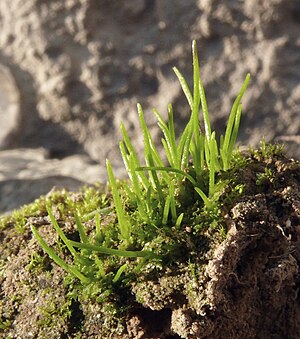Field Hornmoss
| Field Hornmoss | ||||||||||||
|---|---|---|---|---|---|---|---|---|---|---|---|---|

Field Hornmoss ( Anthoceros agrestis ) |
||||||||||||
| Systematics | ||||||||||||
|
||||||||||||
| Scientific name | ||||||||||||
| Anthoceros agrestis | ||||||||||||
| Paton |
The field horn moss ( Anthoceros agrestis ) is a species from the horn moss family .
description
This type of horn moss forms light to pale green, rosette-shaped thalli that are irregularly lobed. They are 0.5 to 1.5 centimeters in diameter. The thallus lobes are wavy to strongly curled and slashed. The multi-layered thallus tissue contains mucous cavities that are often colonized by colonies of Nostoc algae .
The antheridia are formed in groups of 4 to 15 in internal chambers on the top of the thallus and reach a length of 50 to 90 μm. The archegonia lie individually on the top. After fertilization, the horn- or pod-shaped sporophytes develop on the plants, which are between 1 and 3 centimeters long. When the spores ripen, the capsules turn black and open through two longitudinal cracks.
The spores are 38–62 μm in diameter and dark brown to blackish in color. The proximal side of the spores is studded with a network of fused ridges that carry forked spines.
Distribution and ecology
The species is distributed in Central and Southern Europe, North Africa and North America. In Europe, their focus is in the temperate zone. According to its name, the Acker-Hornmoos can be found mainly on agricultural land, especially stubble fields. Most of the time, cereal stubble fields are settled. The species can also be found in patchy meadows, ditch edges and on pond bottoms. Moist, loamy to clayey, neutral to slightly acidic, low-lime soil is preferred. Their ecological behavior can be characterized using the pointer values according to Ellenberg as follows: L 9, T 5, K 5, F 7 and R 4.
It is a pioneer species that can quickly colonize open earth spots. According to the classification of the ecological strategy types of mosses according to During, it is an annual commuter type that occurs briefly after disturbances and survives unfavorable periods due to the storage of large spores (diameter> 20 μm) in the diaspore bank of the soil.
Socialization
The species occurs mainly in the field moss society Pottietum truncatae v. Krus. 1945, as well as in the Kleinling-Hornmoos-Gesellschaft (Centunculo-Anthocerotetum) Koch ex Libbert in 1932. In the former it grows primarily with the Abgestutztem Pott Moss ( Pottia truncata ), the monoecious Braunshorn Moss ( Phaeoceros carolinianus ), the field-free fork tooth moss ( Dicranella staphylina ), the Schleiersporigen Tagmoos ( Ephemerum minutissimum ), the dwarf tip Moss ( Fossombronia pusilla ) and various Star liverwort Species . In the latter, it is associated with the dwarf gauchheil , the toad rush and the swamp dysentery herb.
Hazard and protection
The species is classified as moderately common in Germany. Due to the decline in suitable habitats, especially of stubble fields in agriculture, Anthoceros agrestis is classified in the Red List of Plants in Germany as a type of the warning list (Category V).
Sources and further information
Individual evidence
- ↑ Jan-Peter Frahm: Illustrated key for the thallous liverworts of Germany (= Archive for Bryology. Special Volume 2, ISSN 0945-3466 ). sn, sl 2011, ( online (PDF; 1.12 MB) ). Accessed March 7, 2017.
- ↑ Irene Bisang: The occurrence of hornwort populations (Anthocerotales, Anthocerotopsida) in the Swiss Plateau: The role of management, weather conditions and soil characteristics. In: Lindbergia. Vol. 23, No. 2, 1998, ISSN 0105-0761 , pp. 94-104, JSTOR 20149979 .
- ↑ Heinjo J. During: Life Strategies of bryophytes: a preliminary review. In: Lindbergia. Vol. 5, No. 1, 1979, pp. 2-18, JSTOR 20149317 .
- ↑ Ludwig opinion, Wiebke Schröder: Distribution atlas of the mosses of Germany. Volume 1. Self-published by the Regensburg Botanical Society, Regensburg, 2007.
- ↑ Gabriele Ludwig, Martin Schnittler (Red.): Red List of Endangered Plants in Germany (= series of publications for vegetation science. 28). Federal Agency for Nature Conservation, Bonn-Bad Godesberg 1996, ISBN 3-89624-000-5 .
literature
- Martin Nebel, Georg Philippi (ed.): The mosses of Baden-Württemberg. Volume 3: Special Part. (Bryophyta: Sphagnopsida, Marchantiophyta, Anthocerotophyta). Ulmer, Stuttgart 2005, ISBN 3-8001-3278-8 .
- Jan-Peter Frahm , Wolfgang Frey : Moosflora (= UTB . 1250). 4th, revised and expanded edition. Ulmer, Stuttgart 2004, ISBN 3-8252-1250-5 .